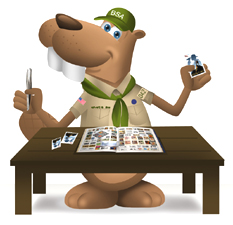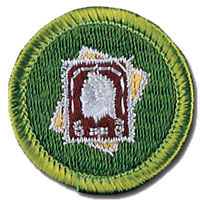Stamp Collecting


Resources
- Stamp Collecting Merit Badge Pamphlet
- Stamp Collecting Merit Badge Class Preparation Page
- Stamp Collecting Merit Badge Workbook
- US Historic Postage Stamp Album compliments of Mystic Stamp Company
- Scoutmaster Bucky's Merit Badge Advancement Quick Reference
- Scoutmaster Bucky's Acknowledgement Form
Stamp Collecting Requirements
Current Scouts BSA requirements
as of December 6, 2025
as of December 6, 2025
1.
Do the following:
a.
Discuss how you can better understand people, places, institutions,
history, and geography as a result of collecting stamps.
b.
Briefly describe some aspects of the history, growth, and development
of the United States postal system. Tell how it is different from
postal systems in other countries.
2.
Define topical stamp collecting. Name and describe three other types of
stamp collections.
3.
Show at least ONE example of each of the following:
a.
Perforated and imperforate stamps
b.
Mint and used stamps
c.
Sheet, booklet, and coil stamps
d.
Numbers on plate block, booklet, coil, or marginal markings
e.
Overprint and surcharge
f.
Metered mail
g.
Definitive, commemorative, semipostal, and airmail stamps
h.
Cancellation and postmark
i.
First day cover
j.
Postal stationery (aerogramme, stamped envelope, and postal card).
4.
Do the following:
a.
Demonstrate the use of ONE standard catalog for several different stamp
issues. Explain why catalog value can vary from the corresponding
purchase price.
b.
Explain the meaning of the term condition as used to describe
a stamp. Show examples that illustrate the different factors that
affect a stamp's value.
5.
Demonstrate the use of at least THREE of the following stamp collector's
tools:
a.
Stamp tongs
b.
Water and tray
c.
Magnifiers
d.
Hinges and stamp mounts
e.
Perforation gauge
f.
Glassine envelopes and cover sleeves
g.
Watermark fluid.
6.
Do the following:
a.
Show a stamp album and how to mount stamps with or without hinges.
Show at least ONE page that displays several stamps.
b.
Discuss at least THREE ways you can help to preserve stamps, covers,
and albums in first-class condition.
7.
Do TWO of the following:
a.
Design a stamp, cancellation, or cachet.
b.
Visit a post office, stamp club, or stamp show with an experienced
collector. Explain what you saw and learned.
c.
Write a review of an interesting article from a stamp newspaper,
magazine, book, or website (with your parent or guardian's permission).
d.
Research and report on a famous stamp-related personality or the
history behind a particular stamp.
e.
Describe the steps taken to produce a stamp. Include the methods of
printing, types of paper, perforation styles, and how they are gummed.
f.
Prepare a two- to three-page display involving stamps. Using ingenuity,
as well as clippings, drawings, etc., tell a story about the stamps ,
and how they relate to history, geography, or a favorite topic of
yours.
8.
Mount and show, in a purchased or homemade album, ONE of the following:
a.
A collection of 250 or more different stamps from at least 15 countries
b.
A collection of a stamp from each of 50 different countries, mounted on
maps to show the location of each
c.
A collection of 100 or more different stamps from either one country or
a group of closely related countries
d.
A collection of 75 or more different stamps on a single topic. (Some
interesting topics are Scouting, birds, insects, the Olympics, sports,
flowers, animals, ships, holidays, trains, famous people, space, and
medicine). Stamps may be from different countries.
e.
A collection of postal items discovered in your mail by monitoring it
over a period of 30 days. Include at least five different types listed
in requirement 3.